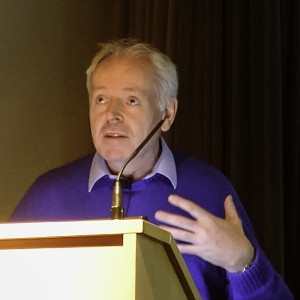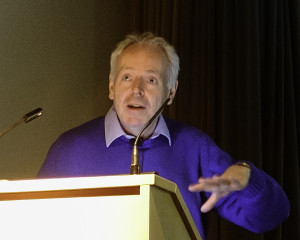March 10, 2014
Cassini at Saturn: Life at the Edge
Professor Carl Murray
Report by: Chris Sutcliffe and Mike Meynell
Professor Carl Murray from Queen Mary College, London, returned to the Flamsteed for his 4th appearance over the last 10 years, to give us an update on the Cassini mission to Saturn (see links to previous lecture reports at the end of this report). Carl joked that the Flamsteed were like a second family, as he comes to us every few years to give an update on what he’s been doing… almost like a confessional experience!
Carl’s main area of interest is just at the edge of the main rings of Saturn, going out to the “F-ring”, hence the title of his talk “Life at the Edge”. Perhaps many people would think that studying the main rings of Saturn, the A and B rings that are separated by the Cassini Division, would be more interesting, but Carl sought to convince us otherwise, in a fascinating talk about one of the most dynamic areas of the Solar System.
Carl visited Greenwich in the early 1990s with his wife, when he found a shop selling a reprinted edition titled “Dan Dare: Operation Saturn”. It reminded him of his youth when he visited Belfast City Library and he saw bound editions of “The Eagle” comic. He was fascinated by science fiction, but never dreamt that he would be involved in an actual mission to Saturn.
Carl first showed us the famous mosaic image of Saturn, taken by Cassini on 19 July 2013, when we were all asked to wave at Saturn. To the right of Saturn, just below the rings, you can see a small dot, which is actually an image of the Earth as seen from Saturn.
As background to the mission, Carl explained that the Cassini-Huygens mission is a joint NASA/ESA/ASI mission, which was launched in October 1997, arriving at Saturn in July 2004 to begin a 4-year tour of the Saturn system. Obviously, they are now approaching their 10th anniversary, and hope to continue for longer, so the mission has clearly exceeded all expectations.
Saturn’s ring system is the largest in terms of area and mass of all the ring systems in the Solar System. Jupiter, Uranus and Neptune also have ring systems, but Saturn’s is by far the largest. It is composed of water ice (at least 90%) and some impurities. We still don’t know the make up of these impurities. The origin of the rings is very much open to debate – it may have been caused by the break up of a giant comet or other large satellite, broken up by the gravitational tidal forces of Saturn.
The rings are probably no older than 200-400 million years old. They are unlikely to be any older than this, as the ring system should have dissipated if the rings were any older. Possibly, this is just the latest version of Saturn’s rings – perhaps they come and go over time – we just don’t know.
The rings are no more than around 10 metres in thickness, most likely because of collisions, with the end result being that the material is forced down to the equatorial plane. Gaps in the rings can be caused by moons clearing a path within the ring system, but we don’t really know what causes all of the gaps.
Carl showed us some time-lapse movies of the F-ring, typically taken over a period of several hours. It is possible to see some very strange behaviour in the F-ring, with rippling and mini-jets being produced. Some of the strange behaviour is caused by the moons Prometheus and Pandora and also collisional events from other objects, which perturb the F-ring. By studying this behaviour, Carl and the Cassini Imaging team have discovered new moons of Saturn, such as S/2004 S6.
Objects that are too small to cause gaps in the rings create “propellers”. The object “Blériot” is an example and is an object that gives the first evidence of orbital evolution inside a disk. Clearly, this is of huge interest when studying the evolution of objects within the Solar System and other planetary systems.
In late 2013, Carl and his colleagues were looking at pictures of Prometheus when they noticed a distortion in the A-ring, which could be the beginnings of a new moon. Carl has named the object “Peggy” after his mother-in-law.
Carl finished up by saying that the mission will probably conclude in September 2017, though funding has not yet been agreed.
We are sure to invite Carl back for his concluding talk on the subject after 2017!
Reports from previous lectures by Professor Carl Murray at the Flamsteed:
Pictures from the Evening (by Mike Meynell):
Posted under: Flamsteed, Flamsteed Lecture, Meeting Report







You must be logged in to post a comment.